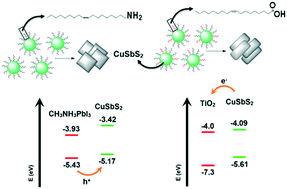Effect of sulfonating agent and ligand chemistry on structural and optical properties of CuSbS2 particles prepared by heat-up method
Abstract
Chalcostibite copper antimony sulfide (CuSbS2) is a promising candidate for application in solar cells. The functionality of CuSbS2 particles depends on particle size and morphology and controlling these two parameters during synthesis is of utmost importance. In this study, CuSbS2 particles were prepared by a facile heat-up synthesis method utilizing sulfur powder (Su) and thiourea (Tu) to investigate the effect of the sulfur source on the structural and physical properties of CuSbS2 particles. Different morphologies were observed when Su and Tu were employed. The results demonstrated that the shape uniformity can be improved by applying a coordinating sulfur precursor (Tu). Moreover, nanoplatelet- and nanobrick-shaped particles were obtained by changing the ligand chemistry, i.e., by using a different combination of oleylamine (OLA), 1-octadecene (ODE), and oleic acid (OL). Band gap calculations showed that CuSbS2 had direct and indirect bandgaps with a small difference of 0.2 eV. Composition analysis of samples obtained from the Tu precursor revealed that antimony contents varied resulting in differences of the lattice parameter c. Moreover, valence band (VB) and conduction band (CB) positions determined by cyclic voltammetry (CV) suggested that this material based on its composition can have dual applications: first, as an absorber in nanocrystalline solar cells and second, as a hole transport material in perovskite solar cells.



 Please wait while we load your content...
Please wait while we load your content...